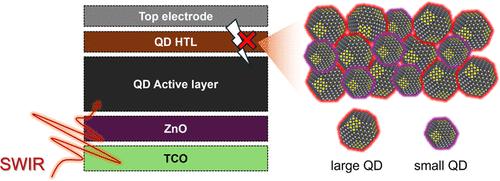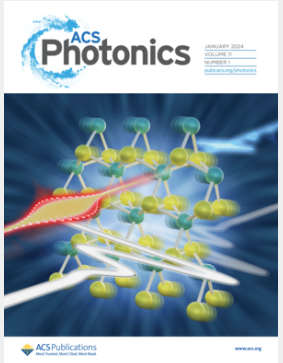空穴传输层中混合尺寸量子点对短波红外探测器暗电流密度的影响
IF 6.5
1区 物理与天体物理
Q1 MATERIALS SCIENCE, MULTIDISCIPLINARY
引用次数: 0
摘要
PbS量子点由于其独特的光学特性和可调谐的带隙,是低成本短波红外(SWIR)光探测和成像应用的有前途的材料。高性能光电二极管依赖于巯基处理的小PbS量子点作为空穴传输层(HTL),因为它们具有合适的能带排列,但它们面临着诸如裂纹形成等挑战,这会增加暗电流。我们通过混合小尺寸和大尺寸量子点来开发无裂纹的html。掠入射小角度x射线散射数据证实,混合尺寸量子点HTL比单尺寸量子点HTL更均匀,密度更大。光物理研究表明,与单尺寸量子点相比,混合尺寸量子点的载流子动力学和能量传递得到了优化。基于混合尺寸QD HTL的器件显示出明显降低的暗电流密度(392 nA/cm2)。此外,它们还具有较高的器件性能,包括响应率为0.65 a /W,探测率为2.4 × 1012 Jones, SWIR区域的外部量子效率为65%,为高性能基于qd的SWIR光电探测器铺平了道路。本文章由计算机程序翻译,如有差异,请以英文原文为准。

Hybrid-Size Quantum Dots in Hole Transport Layer Depress Dark Current Density of Short-Wave Infrared Photodetectors
PbS quantum dots (QDs) are promising materials for low-cost short-wave infrared (SWIR) photodetection and imaging applications, owing to their unique optical properties and tunable bandgap. High-performance photodiodes rely on thiol-treated small PbS QDs as the hole transport layer (HTL) due to their suitable band alignment, but they face challenges such as crack formation, which increases dark currents. We develop a crack-free HTL by mixing small-size and large-size QDs. Grazing incidence small-angle X-ray scattering data confirms that the hybrid-size QD HTL is more homogeneous and denser than that made from monosize QDs. Photophysical studies show optimized charge carrier dynamics and energy transfer in the hybrid-size QDs, compared to monosize QDs. The devices based on the hybrid-size QD HTL exhibit a significantly reduced dark current density (392 nA/cm2). Additionally, they show high device performance, including a responsivity of 0.65 A/W, detectivity of 2.4 × 1012 Jones, and an external quantum efficiency of 65% in the SWIR region, paving the way for high-performance QD-based SWIR photodetectors.
求助全文
通过发布文献求助,成功后即可免费获取论文全文。
去求助
来源期刊

ACS Photonics
NANOSCIENCE & NANOTECHNOLOGY-MATERIALS SCIENCE, MULTIDISCIPLINARY
CiteScore
11.90
自引率
5.70%
发文量
438
审稿时长
2.3 months
期刊介绍:
Published as soon as accepted and summarized in monthly issues, ACS Photonics will publish Research Articles, Letters, Perspectives, and Reviews, to encompass the full scope of published research in this field.
 求助内容:
求助内容: 应助结果提醒方式:
应助结果提醒方式:


